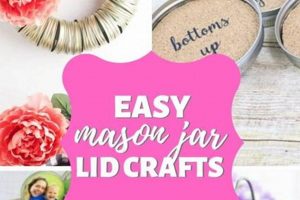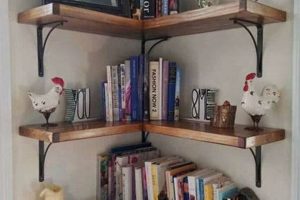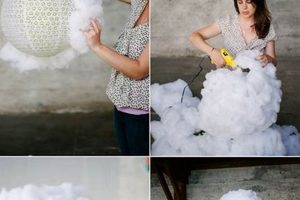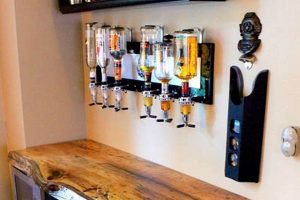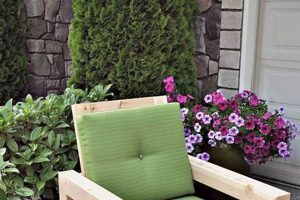The creation of miniature, self-contained worlds within glass orbs offers a compelling blend of crafting and personalized expression. The concept involves encapsulating a scene or figure within a liquid-filled sphere, typically enhanced with particulate matter that simulates snowfall upon agitation. An example includes a handcrafted winter landscape featuring polymer clay figurines nestled within a jar filled with water, glitter, and sealant.
The practice holds significance for its accessibility, allowing individuals of varying skill levels to engage in creative pursuits. Benefits extend to personalized gift-giving, seasonal decorating, and the preservation of sentimental objects. Historically, these decorative items have evolved from elaborate, expensive novelties to accessible, do-it-yourself projects.
The subsequent sections will elaborate on specific techniques for constructing these decorative items, outlining necessary materials, detailing procedural steps, and providing examples of creative variations and personalization options.
Construction Recommendations
The following recommendations aim to enhance the longevity and aesthetic appeal of self-made encased decorative spheres.
Tip 1: Container Selection: Choose a robust glass jar with a wide mouth for ease of assembly. Ensure the lid provides a watertight seal to prevent leakage and evaporation.
Tip 2: Figurine Material: Opt for polymer clay or plastic figurines rather than porous materials, as these are less likely to degrade or discolor in liquid. Thoroughly seal any painted components to prevent leaching of pigments.
Tip 3: Liquid Composition: Utilize distilled water to minimize clouding and bacterial growth. The addition of glycerin or clear glue can increase the viscosity of the liquid, causing the particulate matter to descend more slowly.
Tip 4: Adhesive Application: Employ a waterproof, non-toxic adhesive, such as epoxy resin or silicone sealant, to securely affix the figurine base to the inside of the jar lid. Allow adequate curing time before immersion.
Tip 5: Particulate Selection: Select fine, non-bleeding glitter, artificial snow, or other inert materials to simulate snowfall. Avoid using organic matter, as it may decompose and discolor the water.
Tip 6: Sealing Integrity: Before final assembly, test the seal by filling the jar with water and inverting it. Address any leaks with additional sealant and allow it to fully cure.
Tip 7: Avoiding Air Bubbles: Fill the jar completely to minimize air bubbles, which can detract from the visual appeal. Gently tap the jar to release trapped air before sealing.
Adherence to these guidelines will contribute to a more durable and visually appealing final product.
The subsequent section will address common challenges encountered during the creation process and propose solutions to mitigate them.
1. Container Selection
Container selection exerts a direct and significant influence on the outcome of encased decorative sphere projects. The vessel’s characteristicssize, shape, material, and sealing mechanismfundamentally determine the feasibility, aesthetic qualities, and longevity of the completed item. Insufficient consideration of these factors can lead to instability, leakage, visual distortion, or even catastrophic failure of the project. For example, a container with a narrow opening restricts the size of figurines that can be accommodated, while an improperly sealed container invites water damage and promotes microbial growth. The choice of glass over plastic, while offering superior visual clarity, necessitates careful handling due to its inherent fragility. Thus, container selection is not merely a preliminary step but a critical determinant of success.
Practical application of informed container selection involves assessing several key attributes. The container’s material must be compatible with prolonged immersion in liquid, resisting degradation or leaching of harmful substances. The sealing mechanism must provide a hermetic barrier, preventing evaporation and contamination. The size of the container must be commensurate with the intended scene, allowing adequate space for figurines, particulate matter, and liquid volume. For instance, using a repurposed mason jar with a rubber-gasketed lid provides a robust and aesthetically pleasing solution, while ensuring a watertight seal. Conversely, employing a thin-walled plastic container with a poorly fitting lid would likely result in an inferior and short-lived creation.
In summary, the correlation between container selection and the overall success of encased decorative sphere creations is undeniable. Prioritizing robust, chemically inert, and well-sealed containers is paramount. Overlooking these considerations introduces avoidable risks and diminishes the potential for a durable and visually captivating final product. Careful consideration of this element is, therefore, central to achieving successful and lasting results in this craft.
2. Figurine Suitability
Figurine suitability represents a critical factor in the successful creation of encased decorative spheres. The selection of appropriate materials and designs directly impacts the long-term aesthetic appeal and structural integrity of the finished item. The use of unsuitable figurines precipitates discoloration of the surrounding liquid, disintegration of the figure itself, and overall degradation of the enclosed environment. For example, employing a water-soluble paint on a clay figurine will inevitably lead to the paint dissolving into the water, clouding the liquid and diminishing the visual quality of the sphere. Conversely, selecting figurines crafted from waterproof materials, such as polymer clay or sealed plastic, mitigates these risks.
The practical significance of understanding figurine suitability extends beyond mere aesthetic considerations. The chemical composition of the figurine can influence the clarity and stability of the liquid medium. Certain materials may leach harmful substances into the water, promoting bacterial growth or reacting with other components within the sphere. To address this, figurines should be selected with consideration for their inertness and compatibility with the intended liquid. Furthermore, the size and scale of the figurine must harmonize with the dimensions of the container; an overly large figurine may crowd the sphere, while an excessively small figurine may appear insignificant and fail to create the desired visual impact. For instance, utilizing a lead-based miniature would pose health risks and contaminate the liquid, while a properly sealed plastic figurine would not.
In conclusion, ensuring figurine suitability is paramount to achieving a durable and visually pleasing encased decorative sphere. Diligent selection of materials resistant to degradation and compatible with the li
quid environment minimizes the potential for complications and maximizes the longevity of the creation. Overlooking this essential element compromises the overall quality and diminishes the intended impact of the completed project. Prioritizing the appropriate selection of figurines directly correlates with the successful realization of a lasting and aesthetically pleasing display.
3. Liquid Clarity
The visual impact of a handcrafted encased decorative sphere is directly contingent upon the clarity of the liquid medium. Turbidity or discoloration undermines the intended aesthetic, obscuring the encapsulated scene and detracting from the overall effect. Maintenance of optimal liquid clarity is therefore a critical consideration in the creation process.
- Water Quality
The base liquid significantly influences long-term clarity. Distilled water is preferred to minimize mineral content and microbial growth, both of which contribute to cloudiness. Tap water, with its inherent impurities, is generally unsuitable for sustained clarity. Even subtle differences in water purity impact the final presentation.
- Material Compatibility
The materials used for figurines and decorative elements must be chemically inert within the chosen liquid. Certain paints, adhesives, or plastics leach substances into the water, causing discoloration or turbidity. Careful selection of non-reactive components is essential for preserving clarity. For example, using non-toxic, waterproof sealant will avoid clouding from adhesive leaching.
- Additive Selection
Additives, such as glycerin or clear glue, are often used to increase liquid viscosity and slow the descent of particulate matter. However, these substances must be of high quality and added in appropriate concentrations. Overuse leads to cloudiness, while inferior products may introduce impurities. The selection and precise measurement of additives are crucial.
- Preventing Microbial Growth
Even with distilled water, microbial growth can occur over time, compromising clarity. The addition of a small amount of antimicrobial agent, such as a diluted bleach solution or commercially available water clarifier, inhibits this growth. However, caution must be exercised to avoid damaging figurines or altering the liquid’s properties. Testing the antimicrobial agent on a sample beforehand is advisable.
The preceding facets illustrate the multifaceted nature of liquid clarity in the context of these handcrafted encased decorations. Meticulous attention to water quality, material compatibility, additive selection, and microbial control directly translates into a visually superior and more enduring finished product. The value placed on a crystal-clear liquid medium underscores its central role in realizing the intended aesthetic of the enclosed miniature world. Ignoring or underestimating the factors that promote clarity inevitably diminishes the visual appeal and longevity of the final sphere.
4. Sealing Integrity
Sealing integrity is paramount to the functionality and longevity of handcrafted encased decorative spheres. The enclosure’s capacity to prevent fluid leakage and maintain an uncontaminated internal environment directly determines its viability as a decorative item. A compromised seal invites water damage to surrounding surfaces, fosters microbial growth within the sphere, and diminishes the aesthetic value of the contained scene. The implementation of effective sealing techniques constitutes a non-negotiable aspect of the construction process.
- Material Compatibility
The adhesive or sealant employed must exhibit compatibility with both the container material (typically glass or plastic) and the lid material. Incompatible materials can lead to degradation of the sealant, loss of adhesion, and eventual leakage. For instance, silicone sealants generally adhere well to glass but may require surface preparation for optimal bonding to certain plastics. Matching the sealant chemistry to the substrate is essential for long-term performance.
- Surface Preparation
Thorough cleaning and degreasing of the bonding surfaces is critical to ensure proper adhesion. Contaminants such as oils, dust, or residual mold release agents impede the formation of a strong bond. Isopropyl alcohol or a specialized surface cleaner should be used to prepare the surfaces immediately prior to applying the sealant. Neglecting this step significantly increases the risk of seal failure.
- Application Technique
The sealant must be applied in a uniform and continuous bead, ensuring complete coverage of the joint between the container and the lid. Gaps or voids in the sealant layer provide pathways for fluid leakage. Applying consistent pressure during assembly ensures intimate contact between the surfaces and promotes optimal bond formation. Over-application of sealant, while seemingly beneficial, can lead to messy aesthetics and potential interference with the lid closure.
- Curing Process
Adequate curing time must be allowed for the sealant to fully cross-link and develop its maximum strength. Premature handling or immersion in liquid can compromise the bond and lead to leakage. The manufacturer’s recommendations regarding curing time and temperature should be strictly followed. Elevated humidity levels can sometimes prolong the curing process, necessitating additional waiting time.
These elements underscore the significance of meticulous attention to detail in sealing these handcrafted spheres. A single lapse in material selection, surface preparation, application technique, or curing process can compromise the entire project. Prioritizing these aspects is essential for achieving a leak-proof and aesthetically pleasing result, thereby ensuring the longevity and value of the decorative creation. Sealing, therefore, represents a critical gate in the overall construction process.
5. Snow Simulation
The simulation of falling snow within encased decorative spheres constitutes a central element of their aesthetic appeal and thematic essence. Effective replication of snowfall relies on careful selection of materials and techniques, directly influencing the visual realism and overall success of the completed project.
- Particulate Material Selection
The choice of material used to simulate snow dictates its appearance and behavior within the liquid medium. Finely ground glitter, artificial snow flakes (typically composed of polymer or plastic), and iridescent powders are commonly employed. The size, shape, and density of these particles affect their rate of descent and dispersion, influencing the perceived realism of the snowfall effect. For example, heavier particles sink more quickly, creating a less ethereal effect than lighter, more slowly descending particles.
- Liquid Viscosity Modulation
The viscosity of the liquid within the sphere plays a crucial role in controlling the rate at which simulated snow falls. Higher viscosity liquids, often achieved through the addition o
f glycerin or clear glue, slow the descent of particles, creating a more sustained and visually appealing snowfall effect. The optimal viscosity balances realism with visual clarity, preventing the liquid from becoming excessively cloudy or sluggish. Overly viscous solutions hinder the movement of particles, diminishing the desired simulation. - Color and Reflectivity Considerations
The color and reflectivity of the simulated snow influence the overall brightness and visual texture of the enclosed scene. White or iridescent particles are commonly chosen to mimic the appearance of natural snow. However, the addition of subtle color variations, such as pale blues or silvers, can enhance the realism and depth of the simulation. Highly reflective particles create a sparkling effect, while matte particles produce a softer, more diffuse appearance. The selection depends on the desired aesthetic outcome.
- Particle Suspension Techniques
Techniques for suspending particles evenly throughout the liquid medium contribute to the overall realism of the snowfall simulation. Thorough mixing of the particles with the liquid prior to sealing the sphere ensures a uniform distribution. In some cases, the addition of a small amount of surfactant (a surface-active agent) can help to prevent particles from clumping together or settling too quickly. Controlled particle suspension is crucial for achieving a balanced and visually appealing simulation.
The successful implementation of snow simulation techniques significantly enhances the aesthetic value of encased decorative spheres, providing a captivating miniature representation of a winter landscape. The thoughtful selection of particulate materials, careful modulation of liquid viscosity, and strategic application of particle suspension techniques contribute to a visually compelling and realistic simulation of falling snow, thereby augmenting the overall appeal and thematic resonance of the handcrafted creation.
Frequently Asked Questions
The following questions address common inquiries and concerns related to constructing encased decorative spheres, offering guidance on materials, techniques, and potential challenges.
Question 1: What types of containers are most suitable for crafting encased decorative spheres?
Durable glass jars with wide mouths and tight-sealing lids are generally recommended. These provide clarity, stability, and ease of assembly. The lid must be capable of forming a watertight seal to prevent leakage and evaporation.
Question 2: Which materials are appropriate for figurines placed within encased decorative spheres?
Polymer clay and plastic figurines are preferred due to their resistance to degradation in liquid. Porous materials should be avoided, as they can absorb water, discolor, or disintegrate over time.
Question 3: What type of liquid should be used within encased decorative spheres?
Distilled water is recommended to minimize clouding and bacterial growth. Glycerin or clear glue can be added to increase viscosity and slow the descent of particulate matter, simulating snowfall.
Question 4: How can leaks be prevented in encased decorative spheres?
A waterproof, non-toxic adhesive, such as epoxy resin or silicone sealant, should be used to secure the figurine base to the inside of the jar lid. Ensure a complete, unbroken seal and allow adequate curing time before filling the sphere with liquid.
Question 5: What materials are best for simulating snow within encased decorative spheres?
Fine, non-bleeding glitter or artificial snow are commonly used. Avoid organic matter, as it can decompose and discolor the water. The particle size influences the rate of descent, impacting the realism of the snowfall effect.
Question 6: How can air bubbles be minimized within encased decorative spheres?
Fill the jar completely with liquid, leaving minimal airspace. Gently tap the jar to release trapped air before sealing the lid. A small amount of clear glue can also aid in displacing trapped air.
In summary, meticulous attention to material selection, sealing techniques, and liquid composition is crucial for producing durable and visually appealing encased decorative spheres. Careful execution of each step mitigates potential problems and maximizes the longevity of the creation.
The following section will delve into specific design variations and personalization options for creating unique and expressive encased decorative spheres.
Conclusion
The preceding examination of “snow globe diy ideas” has elucidated fundamental aspects critical to the creation of durable and aesthetically pleasing encased decorative spheres. Emphasis has been placed on material selection, construction techniques, and potential challenges inherent in these projects. Adherence to established best practices regarding container integrity, figurine suitability, liquid clarity, sealing efficacy, and snow simulation is essential for realizing a satisfactory outcome.
The crafting of these miniature encapsulated worlds presents an opportunity for personalized expression and creative exploration. Continued refinement of techniques and a commitment to quality will yield increasingly sophisticated and enduring creations. Further investigation into advanced materials and innovative design approaches promises to expand the potential of this craft.


